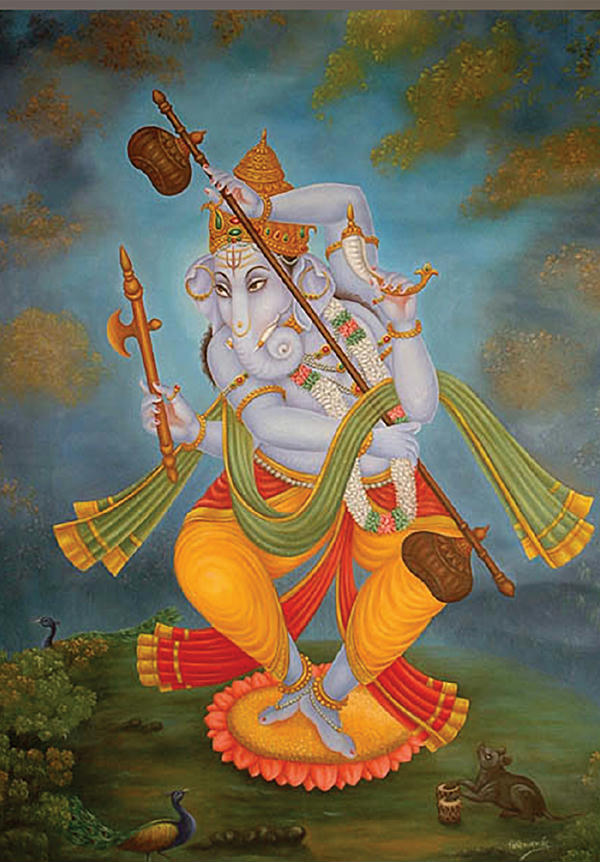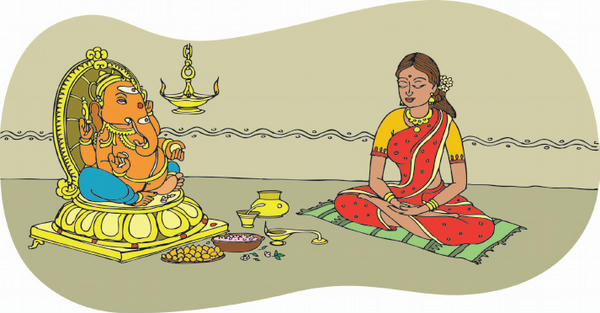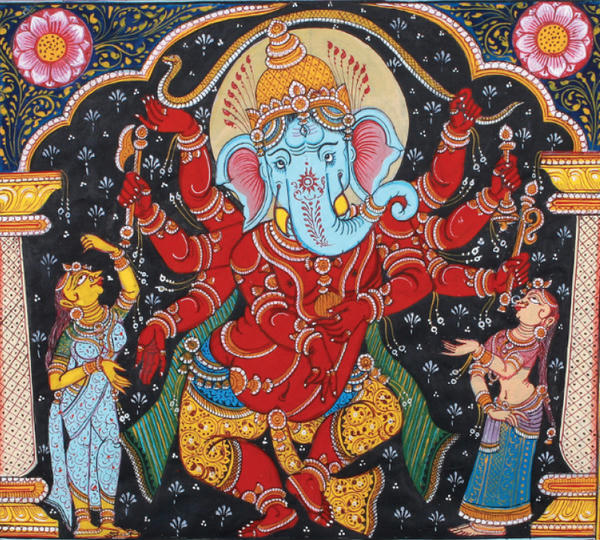The Nature of Lord Gaṇeśa§
Śrī Gaṇeśasya Svabhāvaḥ§
श्रीगणेशस्य स्वभावः§
 TRIAD OF THREE GREAT PILLARS HAVE HELD HINDUISM HIGH, CENtury after century: the satgurus, the temples and the scriptures. Together they echo the greatness of the loving God Gaṇeśa, the Lord of Dharma, son of Śiva. For untold millennia our ṛishis and sages have proclaimed the profound depths of the mind, assuring us that we, too, can and must come to know God and the Gods. It is the living presence of these satgurus and their spoken teachings which has brought to life the traditional practices and philosophy of the Sanātana Dharma. Now we shall delve into the nature of Lord Gaṇeśa, what He is like, what functions this great God performs and find out how each seeker can make Him a vital part of daily life’s path of experience.§
TRIAD OF THREE GREAT PILLARS HAVE HELD HINDUISM HIGH, CENtury after century: the satgurus, the temples and the scriptures. Together they echo the greatness of the loving God Gaṇeśa, the Lord of Dharma, son of Śiva. For untold millennia our ṛishis and sages have proclaimed the profound depths of the mind, assuring us that we, too, can and must come to know God and the Gods. It is the living presence of these satgurus and their spoken teachings which has brought to life the traditional practices and philosophy of the Sanātana Dharma. Now we shall delve into the nature of Lord Gaṇeśa, what He is like, what functions this great God performs and find out how each seeker can make Him a vital part of daily life’s path of experience.§
Once a psychic connection is made with Lord Gaṇeśa—the Deity who manifests in several forms, including the elephant-headed Lord of Categories and Remover of Obstacles—one is brought slowly into the mysteries of the Sanātana Dharma. Such an inner connection, which can be as subtle as a feeling, as tenuous as a dream or as bold as a personal visit, is also an entering into one’s own mūlādhāra chakra, governed by the planet Mercury, for every opening into a new chakra is also an introduction to the Deity who governs that state of consciousness and the planet to which that chakra is connected.§
The Sanātana Dharma, known today as Hinduism, is the only living religion on the planet that does not look to a human founder for its source of inspiration, scripture or historical beginning. It is timeless and ageless. Sanātana Dharma, the root religion of humankind, looks inward for its origins, into the subtlest superconscious realm within the microcosm, which it calls the Kāraṇaloka, Śivaloka or Third World. This great religion has no single organized headquarters on the material plane. Nor does it have a one hierarchy. Who then is in charge of Hinduism? Why, it is none other than our loving Gaṇeśa! He doesn’t live in Rome or in Salt Lake City. Lord Gaṇeśa lives simultaneously everywhere Hindus worship and pray within themselves. He doesn’t have to be reappointed from time to time, because yugas and yugas ago He was permanently and irrevocably appointed when He was created for this work.§
Gaṇeśa, the Great Gatekeeper§
 Yes, it is the Great Gaṇeśa who is the gateway for seekers into the world’s most ancient faith. He is the inner authority, the guardian, the one who grants access to the spiritual mysteries of the Sanātana Dharma. All Hindus worship Him, regardless of their sectarian or philosophical positions. He truly binds them together in His love. This great God is both the beginning of the Hindu religion and the meeting ground for all its devotees. And that is only proper, inasmuch as Gaṇeśa is the personification of the material universe. The universe in all of its varied and various magnificent manifestations is nothing but the body of this cheerfully portly God.§
Yes, it is the Great Gaṇeśa who is the gateway for seekers into the world’s most ancient faith. He is the inner authority, the guardian, the one who grants access to the spiritual mysteries of the Sanātana Dharma. All Hindus worship Him, regardless of their sectarian or philosophical positions. He truly binds them together in His love. This great God is both the beginning of the Hindu religion and the meeting ground for all its devotees. And that is only proper, inasmuch as Gaṇeśa is the personification of the material universe. The universe in all of its varied and various magnificent manifestations is nothing but the body of this cheerfully portly God.§
Gaṇeśa sits on the psychic lotus of the mūlādhāra chakra, the ganglia of nerves at the base of the spine within everyone. This chakra governs time, matter and memory. As the spiritual aspirant is lifted up from fear and confusion into conscious awareness of right thought, right speech and right action, the mūlādhāra chakra becomes activated. It is then that the seeker, with heart filled with love, encounters the holy feet of Lord Gaṇeśa. As the spiritual seeker worships the loving elephant-faced God, clearness of mind comes more and more as he automatically and very slowly enters the Hindu path to enlightenment. Once the connection is firmly established between the devotee and Gaṇeśa, all of the currents of the devotee’s mind and body become harmonized. After that strong connection is made, should he falter on the spiritual path, he has gained divine protection.§
But the seeker loses one thing. He loses his free, instinctive willfulness. It is lost forever. Yet it is not a great loss. Man’s own personal willfulness, his animalistic free will, is a feeble and insignificant force when compared to Lord Gaṇeśa’s divine will. When beholden to God Gaṇeśa and inwardly awakened enough to be attuned to His will, it is then quite natural that the instinctive will bows down. Personal likes and dislikes vanish. Limited faculties of reason and analysis are overpowered and subdued by a greater will, a cosmic will, the will of dharma. When sufficient humility has been awakened, it is easy to surrender personal, instinctive willfulness to the greater subsuperconscious will of dharma. It happens most naturally, but very slowly, because Lord Gaṇeśa, of all the many Gods, proceeds with methodic deliberation. He is the careful, loving guide on the inner path of all seekers.§
Among all the wonderful Hindu Deities, Lord Gaṇeśa is the closest to the material plane of consciousness, most easily contacted and most able to assist us in our day-to-day life and concerns. In His hands Gaṇeśa wields a noose and a goad. With the noose He can hold you close or hold obstacles close. Gaṇeśa can capture and confine both blessings and obstacles. With the goad, Gaṇeśa can strike and repel obstacles. This Lord is called the Remover of Obstacles; but He also places obstacles in our way, for sometimes His devotees are proceeding in the wrong direction, and His obstacles block their progress and guide them slowly back onto the straight path of dharma. When instinctive willfulness causes the seeker to decide to step out of the boundaries of dharma, the Lord of Obstacles is there to block the way. His emblem is the swastika, symbolizing His circuitous course in guiding the seeker through life’s perplexing experiences.§
It is through the worship of Lord Gaṇeśa that we come to know the venerable Lord Murugan, and lastly Supreme God Śiva, their Creator, our Father-Mother God, Lord of all creation, preservation and dissolution.§
Adopted by the Elephant God§
Seekers of Truth come from many backgrounds, many religions, and have trod many paths. Having become acquainted with Lord Gaṇeśa, they may wonder how their past can participate in their present aspirations. “What am I doing worshiping an elephant-faced God and loving it?” they may wonder. “What do I do now to harmonize this unfoldment with my previous upbringing?”§
There is a way to reconcile this subconscious dilemma. Let’s not “pack it away in denial,” as they say; let’s face up to the spiritual awakening. Truth is, you have a loving friend in Gaṇeśa, who, if we may use the word, is the pope of the Hindu religion. And you are by no means alone. One fourth of the human race is acquainted with Gaṇeśa—twenty-five percent of the people on this planet—1.25 billion, and that number is growing year by year.§
Our loving Gaṇeśa leads his devotees deep into the oldest religion on planet Earth. There are two ways to come into Hinduism. One is to be born into the Hindu religion and be carried in your mother’s arms to the temple, there to be inwardly and psychically connected to our loving God, Gaṇeśa. So strong are those early impressions and saṁskāras that they carry you through life. Another way is to unfold naturally to the point of being ready to formally enter Hinduism, to supplicate, to sincerely entreat the guardians of that religion to allow you to be a part of that immense and ancient tradition. You have to want to be a Hindu so strongly, so sincerely, that Lord Gaṇeśa lifts you out of the fog of the materialistic conscious mind, establishing a connection and a relationship with you. This is a personal relationship with the Deity. There is nobody in-between—just you and the God, Lord Gaṇeśa. It’s like being adopted, in a way. If you were an orphan or abandoned on the streets of São Paulo or Madras or on the streets of wherever there are little kids running around, you would be “free.” You could go through life listening to no one and exercising unrestricted free will, free instinctive will. If you had a developed intellect, then you could exercise an intellectual will. You could do anything that you wanted to do, absolutely anything. Of course, you would find that as you attempted to fulfill your desires, you were limited, sometimes prevented, by the natural forces within and without. But you could attempt anything.§
If you were fortunate enough, foster parents might come along to help you. They would adopt you and take you into their home. Your new mother would begin to lovingly guide and direct your life. She would tell you, “You can play as you like in this room, but not in the others.” She is a wise mother and knows that you are accustomed to having your own way, so she lets you play freely within the confines of your own room. But if she catches you playing in another room, she might say firmly, “You may play in your room, not here in this room.” You have lost your “free will” in being adopted by a mother and father, you are a part of their family now, and your well-being, your education, your training all now come under their will, to which you must adjust yourself and obey. They will watch over you and discipline you morning and night. They will protect you from getting into trouble with your “free will.” The modern concept of freedom leads to the darker chakras below the mūlādhāra chakra. Anguish is there.§
Developing a Personal Relationship§
It is the same when you evolve a relationship, a personal relationship, with the Deity Lord Gaṇeśa. He will not allow you to use your free will to get into difficulties. Guiding you carefully and protecting you along your way in your natural karma through life is His concern. Someone once said, “I worship Lord Śiva, I worship Lord Murugan, but I have never really gotten acquainted with Lord Gaṇeśa.” I responded, “You worship Śiva and Lord Murugan, and that is wonderful. But unless you have established a personal relationship with Lord Gaṇeśa, your worship of any of the Gods is probably more according to your own thoughts and fancy than true worship. Until you have established a rapport with Lord Gaṇeśa, you cannot establish a relationship with Kṛishṇa, Ayyappan, Amman, Vishṇu, Rāma, Hanumān, Lakshmī, Sitā, Rādharāṇi, Śiva or Murugan, outside of your own limited concepts. It is Gaṇeśa who introduces you to the millions of Gods of the Hindu pantheon, no one else. That is the way it works.”§
Yes, little by little, slowly, imperceptibly, a relationship evolves, a very personal, loving relationship, between the devotee and the elephant-faced God. Psychic protection is granted, physical protection, mental and emotional protection are all granted as boons by Him. He will not allow His devotees to use their free, instinctive willfulness to make more kukarma by getting into difficulties. Rather, He will guide them carefully, protecting them every moment along the way so that their natural birth karmas may be worked through and sukarma created by right living. This is His main concern. Lord Gaṇeśa loves and cares for His devotees. Once the devotee is connected to Him through the awakening of the mūlādhāra chakra, loneliness is never experienced.§
Gaṇeśa is a truly wonderful, loving God. He has an extraordinary knack for unweaving complicated situations and making them simple. He can unweave his devotees from their karma, simplifying and purifying their lives. But this only happens after they have established a personal relationship with Him. Soon thereafter, changes begin to happen in their lives; and when they go through difficult times, they no longer become angry or live in fear or worry. When difficult times come, they know it is because they are being unwound from accumulated and congested, difficult karmas or being turned in a new direction altogether. They know that at such a time they have to consciously surrender their free, instinctive willfulness and not fight the divine happenings, but allow the God’s divine will to guide their life. Such is the spiritual path of total surrender, known as prapatti.§
The Meaning of Grace§
“What about the grace of the Deity?” seekers ask. Grace is received from the God when you are consistent in your worship, consistent in your discipline, consistent in your bhakti, your devotion. With such a foundation in your life, a great śakti, a force or power, will come from Lord Gaṇeśa. This is grace. It is uplifting. It comes unexpectedly. When grace comes, your mind may change and your heart may melt. Your sight will become clear and penetrating. You may say, “I have been graced to see everything differently.” New doors will begin to open for you, and as you go through them, your life will become more full, more wonderful. And the grace of it is that it would not have ordinarily happened to you.§
Seekers also inquire, “What is the difference between grace and a boon from the Gods?” Grace is not exactly a boon. A boon comes as the result of something that you ask for and receive. A boon is quite specific. Grace comes because of the state of the soul in conjunction with its particular karma. It comes because we have done everything right up to a certain point in time according to the laws of dharma. It is then that the grace of the God comes. Grace is not for a specific need or event in our life, as a boon would be. Grace is more of a complete transformation—a metamorphosis. After receiving grace of a God, the devotee can never be the same again, never look at life again in the old way.§
By grace we are directed deeper into spiritual life, pointed in the right direction, carefully guided on the San Mārga, the straight path to our supreme God. After grace has been received, our thoughts are enlivened, our life is inspired with enthusiasm and energy, and we live daily in the joyous knowledge that everything is all right, everything is happening around us in accord with our karma, our dharma and God’s gracious will.§
The Gods Are Real Beings, Not Mere Symbols§
Many people look at the Gods as mere symbols, representations of forces or mind areas. Actually, the Gods are beings, and down through the ages ordinary men and women, great saints and sages, prophets and mystics in all cultures have inwardly seen, heard and been profoundly influenced by these superconscious, inner-plane, inner-galactic beings. Lord Gaṇeśa is just such a being. He can think just as we can think. He can see and understand and make decisions—decisions so vast in their implications and complexity that we could never comprehend them with our human faculties of limited understanding.§
In recent history, missionaries and others from the Western religions have told the Indian people over and over again that their Gods are not real beings, but merely symbols of spiritual matters—and unfortunately many have begun to believe this and look at their Gods in this way. Even among Hindus there are quite a few who don’t believe in inner-world beings. Their belief is restricted to the people they see in the physical world, and that is all. You dare not tell them differently. It is very difficult, but not impossible, to introduce them to the grand philosophy which is based solely on worship, meditation, inner discipline and the search for Absolute Truth. But this is too high-minded for those living in the everyday materialistic consciousness. For the knowledge of inner worlds to become accepted, a personal realization has to occur. This is a slow process for the materialist, a very slow process, and only Lord Gaṇeśa can help it along. To contact Lord Gaṇeśa, it is imperative that the materialist visit one of His temples or shrines, to make initial contact. It only takes one meeting.§
How to Approach the Deity§
When you approach the Deity, you should believe that Gaṇeśa feels your presence, that He sees you just as you see Him. In thus seeing Him in very human terms, you will get to know Him better. You will develop a very human relationship with Him. It is especially important that you develop this relationship with Lord Gaṇeśa. It will not be difficult to nurture a friendly feeling for Him, because Gaṇeśa is the Deity who governs our instinctive-intellectual state of mind. He governs the instinctive mind of all the animals, the insects, the birds and the fish, and governs, as well, all the forces of prakṛiti, nature. Lord Gaṇeśa is also the Deity who governs the higher intellectual mind, of science and profound knowledge. This is why they call Him Lord of Categories. As Lord of Categories, He organizes and clears the intellectual mind so that individual awareness can flow unhindered in the many areas of developing thought. As Lord of Obstacles, He creates and removes obstacles so that karma becomes more and more perfect as the refinement process of living through the experiences of life continues.§
In the temples of India, even the offerings that come in through the day from pilgrims, who bring silver, gold and gifts of all kinds to be placed into the hundi, are counted at nightfall before the Deity. He sees this and is told of all that was given to Him, and He knows. At night, the Deity is ceremoniously put to bed. They treat Him in very human terms. In the morning He is symbolically awakened, then bathed and dressed. The Deity is treated just as if He were a human person. Well, in the Third World that kind of dedication, intense bhakti, is noticed, and it is appreciated.§
Connecting the Three Worlds: Hindu Magic§
Now you might wonder, “Where are the inner worlds?” It is where you were just before you were conceived. They are in the nonphysical microcosm of this macrocosm. When you were conceived, you began to slowly grow a new physical body inside your mother. At that time you were living in your astral body in the nonphysical microcosm. You existed, to be sure, but not in this physical macrocosm.§
The devas and Deities are all in that nonphysical microcosm. They actually exist inside material existence, for there are many worlds, or planes of existence, within the physical world. If you were to go into the physical microcosm, into a cell and into an atom, and into the inside of that and the inside of that, you would come out in the macrocosm of the Gods. This is called the Śivaloka or Third World. Their macrocosm is bigger than our macrocosm.§
The concept of this inner space is different than we ordinarily conceive. Even though their macrocosm exists within this macrocosm, it is larger than this macrocosm. Of course, that immensity is in another dimension, another world. And each world is larger than the one before—the world of departed souls is larger than this physical world, and the world of the Gods is much larger than the heaven worlds. Therefore, in a tiny space in this physical world hundreds of thousands of devas exist—in a very tiny space.§
Establishing the Link through Pūjā§
When the temple priest invokes the inner worlds and the beings within them, he is consciously trying to establish a channel of communication. When he is successful, this physical microcosm opens into the devonic macrocosm. In other words, through conscious effort he connects the inner and outer worlds, even to the point that devotees may see the transfiguration of the God, or Mahādeva, superimposed over the stone image of the Deity in the temple. They can actually see the God as He is in the inner world. Many, many awakened souls have seen such things—the eyes of the God moving, for instance—and some gurus can actually hear the God speak to them. The God is still in the inner world when this happens. It is the temple that has tuned into His world. This is much like live TV. Hundreds of sets can be tuned into the same station at the same time and view actual happenings as they occur.§
The God, therefore, does not travel from the altar of one temple to the altar of another temple. The procedure is similar to that of dialing a friend on the telephone and bringing his voice across a vast distance into your ear. The friend can be heard quite clearly, but he has not moved to another place. The telephone could be likened to a connection between the gross and the subtle worlds, the world of matter and the worlds of spirit, or ākāśa.§
Where Do We Go When We “Die?”§
Where does the soul go when a person dies? It goes into the subtle microcosm and then into a larger macrocosm, or greater world, and ceases for a time to function in this gross macrocosm because it is not living in a physical body. At death, the soul drops off the physical body and travels in and in and in to subtle worlds, inner worlds of existence that have their own expansive space, their own macrocosm.§
Small children, four or five years old, who can speak but have not yet become too immersed in the learned reality of the conscious or external mind, often tell their parents that they remember when they were born and even before. I have had children tell me, “I came from a world that was bigger than this world.” And they talked about the activities that go on there and described the people living there. Of course, as they grow older and become involved in the external thought processes, these memories fade away. This is the kind of experiential knowledge that makes religion come alive in us, more real and useful. True religion should be the most real and solid and certain thing in our entire life. When we ponder these inner worlds, we learn from within ourselves how they relate and interrelate with each other.§
Ponder the many visions that prophets have spoken of experiencing, of all the angels or devas that have graced mankind with their presence and their prophecies. Ponder the mystic human events that cannot adequately be explained by the rational intellect. Think of them all in terms of the inner worlds of existence, and all will become clear. Yes, one day it will all become clear, from the inside of you to the external intellect. This is real knowing. This is the building of faith. This is true Hinduism, the bedrock of daily life. When this knowing comes from the depths of your knowing state of consciousness, the temple will be the home of the Gods to you.§
Worship and Meditation on Lord Gaṇeśa§
Worship, bhakti yoga, is a definite discipline and practice to be perfected according to the aptitude of the devotee. After bathing and preparing the mind, approach Lord Gaṇeśa in the shrine or temple, bringing a small gift or flower to be placed at His holy feet. Consider that you are approaching and about to meet the most important person in the world. Make your offering and prostrate. As you prostrate, feel the energies of love and devotion flow along your spine and out through the top of the head and into the home shrine altar or sanctum sanctorum, garbhagṛiha, of the temple, and offer those pure actinic energies to Lord Gaṇeśa. Rise and walk slowly three times around the sanctum, always clockwise.§
Meditation, dhyāna yoga, is a discipline you can perform after worshiping that will, when diligently and consistently practiced, bring its own rewards. Sit before the Deity and bring up the images of your own father and mother, then the family guru and finally the darśana of the elephant Lord. Now meditate upon His form, His eyes, His ears, His trunk, His two tusks, His belly, in which rests the whole world. The first time your mind wanders into the thought patterns of daily life, bring it back to your parents, your guru and the first Lord to be worshiped before proceeding on to any other of the 330 million Gods of our ancient Sanātana Dharma.§
The objective is to maintain an unbroken continuity of thought and to not allow the mind to wander away from the darśana of the God. You can begin this meditation by pondering the obvious physical properties of the worshipful image. If it is made of stone, think of the stone. How large is it? Where was it quarried and how was it carved? What are the various parts of the Deity and what do they mean? What are his symbols and what do they mean? Recall them to memory. If it is a picture of Gaṇeśa, ponder how that picture was produced. Continue to explore the Lord Gaṇeśa with your mind. Later you can move on to less physical points of concentration. You will find that your awareness or mind will wander to unrelated areas, to concerns of the past or worries of the future. When it does, bring awareness back to your point of concentration—the Deity, Lord Gaṇeśa. Begin again your stream of thoughts toward Him, and when the mind once again wanders, use your willpower to bring it back to His darśana.§
This may be difficult at first, but constant practice will unfold new knowledge from within you, knowledge that you never knew existed and did not learn from the outside. When that happens, concentration is strong and meditation is not far away. You should be able to have twenty, thirty or even fifty thoughts on loving Gaṇeśa in sequence without awareness being distracted into areas of the external mind. It will help if you learn to breathe diaphragmatically during these exercises. Breathe deeply but naturally, without strain or effort. As we control the prāṇas of the breath, we simultaneously control awareness so that it remains steady and does not move here and there. You also have to teach the body to sit still, to remain poised and not restless. All of this will come in time, not immediately. Be patient. Never become upset with yourself when distractions arise, for that is a greater distraction still. Simply accept each departure from your concentration as an opportunity to become stronger and more one-pointed, and then quietly and firmly bring awareness back to its subject, Lord Gaṇeśa.§
You must teach this simple meditation to your children, and together the entire family will learn much about the Gods of our religion. It will inspire one and all to read more about them, to study their stories and memorize their sacred chants. The Gods will come to life within your own mind and every member of the family as you penetrate behind the symbols and the stories and discover the true nature of Divinities. It is not necessary to practice this meditation for extended periods. A few minutes each day is enough. Once your brief meditation is finished, sit quietly in His darśana and enjoy His energies merging with your own prāṇic radiations. Take that darśana and that love out of the temple when you leave, spreading it among all the peoples of the world that they, too, may come to know and love the endearing God of Hinduism.§




